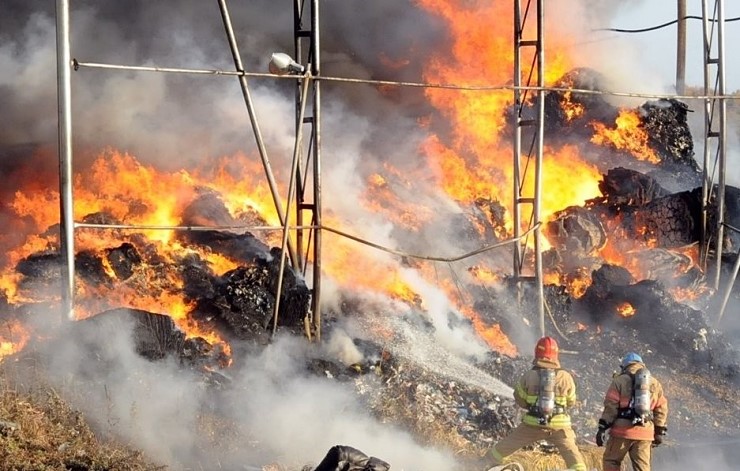 |
| ▲ This picture shows firemen who are having trouble extinguishing fires due to manpower shortage. |
Last April 4th, a massive fire ravaged Goseong, in Gangwon province, spreading along the Eastern Sea shoreline. It was the second-worst forest fire of all time in Korea, sweeping through Goseong, Inje, and Sokcho destroying about 1757ha, an area about 8 million times the size of a soccer field and nearly 5 times the size of Yeouido. 13 people died or were injured in the incident and more than 1000 houses were burned to the ground, while conditions forced more than 4000 people to evacuate from their homes There are so many reasons for the rapid expansion of this disaster including strong winds, the insolvency of the electronic power supply system, the insufficiency of initial responders and so on. However, chief among these reasons is the lack of local firefighting infrastructure. Experts ruled that due to scarce local firefighting resources, local governments could not call in enough manpower needed to fight the spread of the damage. The Dankook Herald (DKH) explored the causes of the forest fire’s massive trail of destruction.
The provinces fire-fighting infrastructures are not well organized.
According to the National Assembly's Security and Public Administration Committee, single person fire-stations are mostly found in remote provinces. In Jeollanam-do province there are 31 stations managed by one person. Also, In Gangwon-do there are nine fire-stations where one firefighter manages more than 100,000 square meters. This tells us that these provinces have a safety blind spot, especially for fires. In particular, Gangwon-do and Jeollanam-do provinces, both of which have a high distribution of mountain areas, are most at risk of forest fire disasters. According to one firefighter, manpower shortages have always been a chronic problem. He also said that a small number of fire stations can impact the initial firefight but the expansion of equipment and personnel are also important issues. The lack of firefighting infrastructure in the provinces is a critical problem. Investigations revealed that if Gangwon-do had had sufficient firefighting infrastructure, the fire could have caused less property damage and firefighters could have saved more lives. Usually, there are at least nine people required for a team of firefighters, but local teams in the provinces are made up of seven people due to a shortage of workers. This is the root cause of why it is harder and takes longer to extinguish a fire in these provinces.
Life and death are decided by the budget of the region.
To learn more about the standard of our firefighting services, we compared our numbers to international firefighting services . According to the National Fire Agency (NFA), Korea’s firefighters are responsible for 1004 citizens per person, while in Japan firefighters are responsible for 779 per person and in the USA its 911. Also, according to the weekly report Kyunghyang, Korea’s firefighters work 84 hours a week or 360 hours a month, while firefighters in the US work 48 hours a week, in Japan 42 hours a week, and in Germany 54. As these numbers illustrate, the shortage of firefighters is much greater in Korea and because of this, they must work longer hours than other countries.
 |
| ▲ This picture shows the capital difference between Seoul and Chungbuk. (Photo from KBS news) |
According to a study completed by the NFA and the University of Seoul, unlike other countries, Korea’s firefighters are also responsible for emergency evacuation, policy and administration. In contrast, France has the Sous-Direction des Services Operationnels (an agency that deals with state emergencies) and a separate firefighting organization while Germany’s central government is responsible for firefighting, it remains predominately a community responsibility unless the fire is large scale and involves multiple cities, then the military or professional emergency services teams intervene. So, because we include more areas of responsibility in our firefighting services, we need more manpower than the other countries. However, our current manpower isn’t enough to cover our needs.
If Korea wants to keep up with reputable firefighting systems found in advanced countries around the world, they are going to need to invest in better infrastructure and policy programs. Firstly, to save citizens in emergency situations and suppress fires, a lot more equipment is needed. Therefore, a budget to expand firefighting equipment and to manage it is also needed. However, since budgets depend upon a provinces’ finances, their interests and investment priorities, firefighting budgets differ from place to place and this causes a regional infrastructure gap. Converting firefighters into national, instead of regional staff, is key to easing any regional gaps in services and will ultimately help aid in the rapid suppression of fires. It will also provide more efficient management of firefighting finances, improve the treatment of firefighters, and expand the manpower and quality of firefighting equipment as their receive better support from the federal government. Overall, transferring the authority and management of firefighting services over to the federal government will enable them to provide stable firefighting services across the country, regardless of the region. It is for these reasons that more than 200,000 people petitioned the government to take over control of firefighting services in just 4 days after the Gangwon-do disaster.
In response, the Minister of Public Administration and Security announced it would recruit 20,000 more firefighters by 2022 in order to reinforce national responsibility for public safety. Also, Gyeonggi province announced the establishment of a Midterm Basic Human Resource Operation Plan to reinforce the number of civil servants on staff, including increasing the number of firefighters by 30.2% by 2023. An increase in number of firefighters is expected help in the rapid suppression of fires and provide a more systematic response when disasters strike.
Most forest fires do not happen because of only one reason and large fires usually have more than one contributing factor such as sparks of electricity, climate change, natural causes, human error and so on. However, it is important to appreciate the sense of urgency that comes along with fires, not just when they happen, but also when the risks are greater. As this case clearly shows, the government and the public have to keep focusing on the deficiencies of our firefighting systems and try to solve the problems before they cost us more lives.
김동은, 신지희, 한혜원, 이지희 dankookherald@gmail.com

 Vote for the Campus Brand Naming!
Vote for the Campus Brand Naming!

![[Campus Magnifier] Let's Surf the Library!](/news/thumbnail/202404/12496_1765_4143_v150.jpg)




